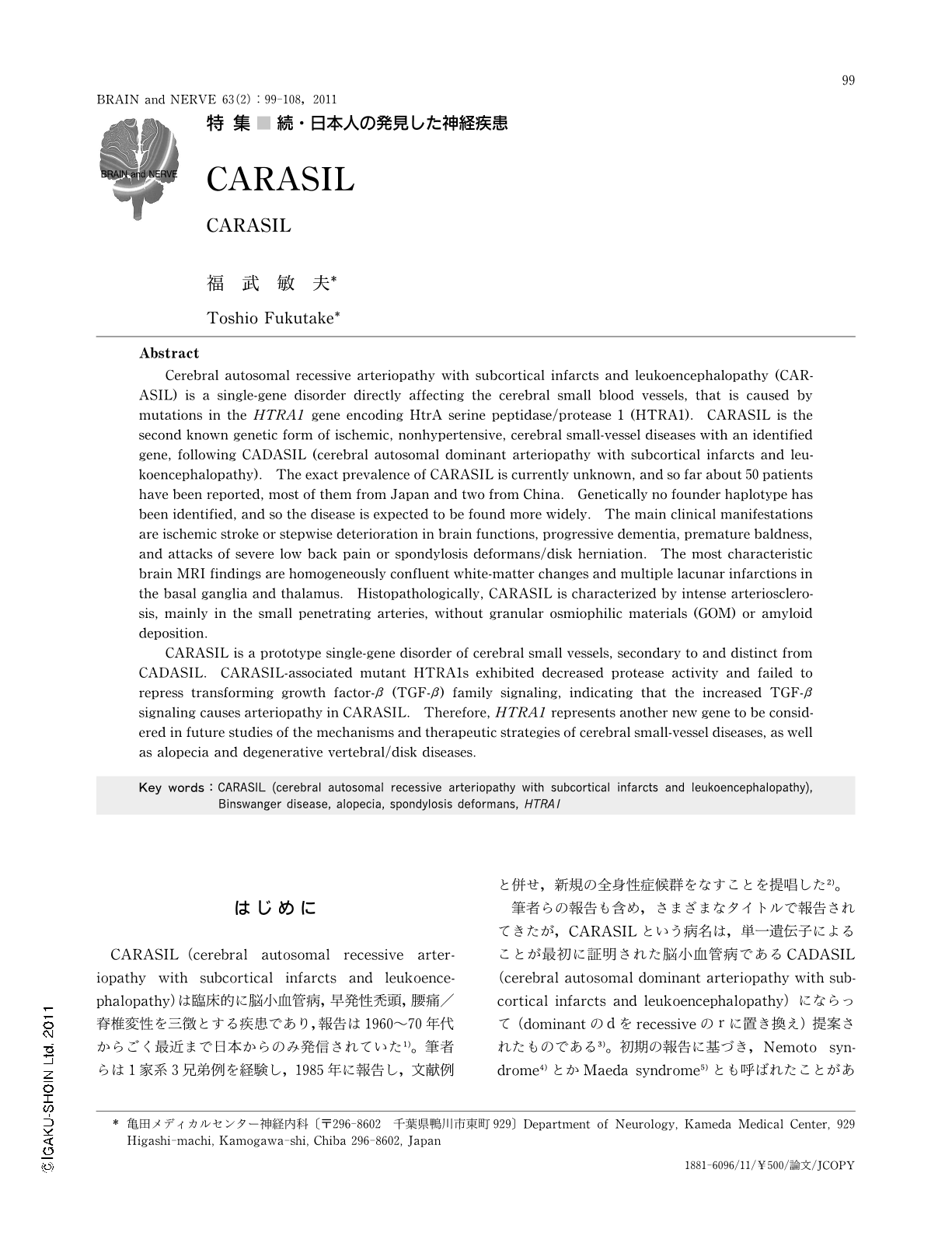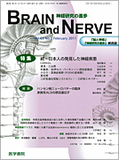Japanese
English
- 有料閲覧
- Abstract 文献概要
- 1ページ目 Look Inside
- 参考文献 Reference
はじめに
CARASIL(cerebral autosomal recessive arteriopathy with subcortical infarcts and leukoencephalopathy)は臨床的に脳小血管病,早発性禿頭,腰痛/脊椎変性を三徴とする疾患であり,報告は1960~70年代からごく最近まで日本からのみ発信されていた1)。筆者らは1家系3兄弟例を経験し,1985年に報告し,文献例と併せ,新規の全身性症候群をなすことを提唱した2)。
筆者らの報告も含め,さまざまなタイトルで報告されてきたが,CARASILという病名は,単一遺伝子によることが最初に証明された脳小血管病であるCADASIL(cerebral autosomal dominant arteriopathy with subcortical infarcts and leukoencephalopathy)にならって(dominantのdをrecessiveのrに置き換え)提案されたものである3)。初期の報告に基づき,Nemoto syndrome4)とかMaeda syndrome5)とも呼ばれたことがあり,現在ではFukutake Diseaseというべきではないかという面映ゆいご提案もあるが,既にCARASILが世界的に広く浸透している6,7)。それはともかく,日本内科学会100年史の神経疾患分野の年表8)と日本神経学会の50年史の年表9)に,日本人の他の綺羅星のごとき業績と並んで「1985年 福武ら:CARASIL疾患概念を提唱」と記載されたのは光栄の至りである。
CARASILは極めて稀な疾患であるが,臨床的に常染色体劣性疾患と考えられ,保因者が多数存在すると考えられる7)ことから,日本に多い脳小血管病の重症モデルといえる10)。ラクナ梗塞やBinswanger病などの血管性脳症の原因として高血圧症や糖尿病などが知られているが,既知の血管危険因子では説明できない症例も多く,また,高血圧などがどのように細動脈硬化を引き起こすのかについてもあまり解明されていない。このため,筆者はCARASILの臨床的診断基準を提案するとともに10-12),日本人による遺伝子解明を期して,神経遺伝学の泰斗たる辻 省次当時新潟大学神経内科教授(現東京大学神経内科教授)の下への検体の集中を呼びかけた。研究を引き継いだ小野寺 理同准教授チームによって,責任遺伝子が10q25に絞り込まれ,最終的に同領域にあるHTRA1遺伝子の変異が同定された13)。
筆者は幸運にもこのように,CARASILの臨床的確立から遺伝子同定までの全過程に関与することができたが,大いなる手掛かりは得られたものの,三徴である脳小血管病,禿頭,脊椎変性発症の詳細な病態機序はまだ十分に解明されておらず,したがって本質的な治療法は手にし得ていない。本稿では,CARASIL研究の歴史的背景,自験家系の長期経過を改めて紹介し,臨床像を整理し,遺伝子解明を踏まえて今後の展望を述べてみたい。
Abstract
Cerebral autosomal recessive arteriopathy with subcortical infarcts and leukoencephalopathy (CARASIL) is a single-gene disorder directly affecting the cerebral small blood vessels, that is caused by mutations in the HTRA1 gene encoding HtrA serine peptidase/protease 1 (HTRA1). CARASIL is the second known genetic form of ischemic, nonhypertensive, cerebral small-vessel diseases with an identified gene, following CADASIL (cerebral autosomal dominant arteriopathy with subcortical infarcts and leukoencephalopathy). The exact prevalence of CARASIL is currently unknown, and so far about 50 patients have been reported, most of them from Japan and two from China. Genetically no founder haplotype has been identified, and so the disease is expected to be found more widely. The main clinical manifestations are ischemic stroke or stepwise deterioration in brain functions, progressive dementia, premature baldness, and attacks of severe low back pain or spondylosis deformans/disk herniation. The most characteristic brain MRI findings are homogeneously confluent white-matter changes and multiple lacunar infarctions in the basal ganglia and thalamus. Histopathologically, CARASIL is characterized by intense arteriosclerosis, mainly in the small penetrating arteries, without granular osmiophilic materials (GOM) or amyloid deposition.
CARASIL is a prototype single-gene disorder of cerebral small vessels,secondary to and distinct from CADASIL. CARASIL-associated mutant HTRA1s exhibited decreased protease activity and failed to repress transforming growth factor-β (TGF-β) family signaling,indicating that the increased TGF-β signaling causes arteriopathy in CARASIL. Therefore,HTRA1 represents another new gene to be considered in future studies of the mechanisms and therapeutic strategies of cerebral small-vessel diseases,as well as alopecia and degenerative vertebral/disk diseases.

Copyright © 2011, Igaku-Shoin Ltd. All rights reserved.


